Impact of Low-Emission Zones on Spatial and Economic Inequalities using a Dynamic Transport Simulator
André de Palma, Lucas Javaudin
CY Cergy Paris Université
ITEA 2023-06-14
Introduction
Context
- Each year 430,000 Europeans die prematurely due to air pollution (European parliament)
- Air pollution is mainly caused by nitrogen oxides (NOx) and particulate matter (PM) emitted by road vehicles
- Popular instrument to improve air quality: Low Emission Zones (LEZ)
Low Emission Zones
- In Europe, LEZs have been implemented in hundreds of cities
- Starting in 2025, LEZs will be mandatory for French cities with more than 150,000 inhabitants
- Benefits of LEZs: reducing local and global air pollution, congestion and noise pollution
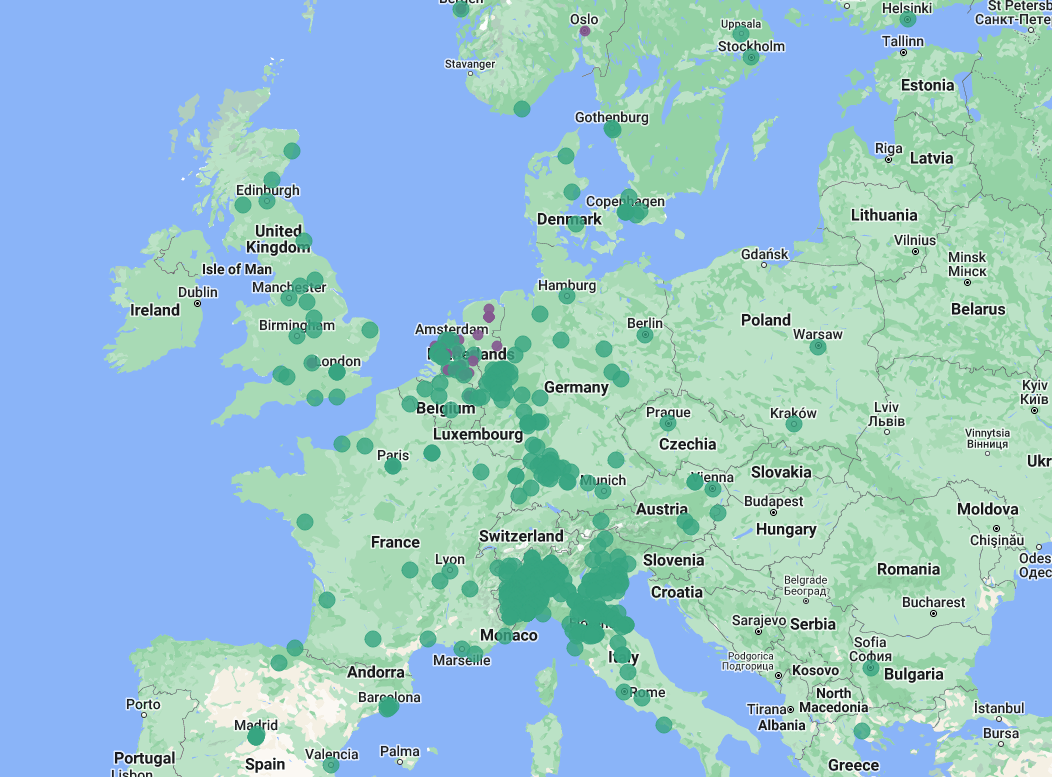
Source: urbanaccessregulations.eu
A Controversial Policy
"An ordeal", "unfair", "stressful": the LEZs, new nightmare for the drivers


In Lyon, the project of extending the LEZ brings upheaval


Paris' Low Emission Zone
- More than 5 million inhabintants are living in the LEZ
- The LEZ represent around 10 % of the Île-de-France's road network
- June 2021: Crit'air 4 vehicles and worse are banned (11 % of the fleet)
- July 2023: Crit'air 3 vehicles and worse are banned (34 % of the fleet)
- 68 € fine for non-respect (traffic-camera ticketing is planned)

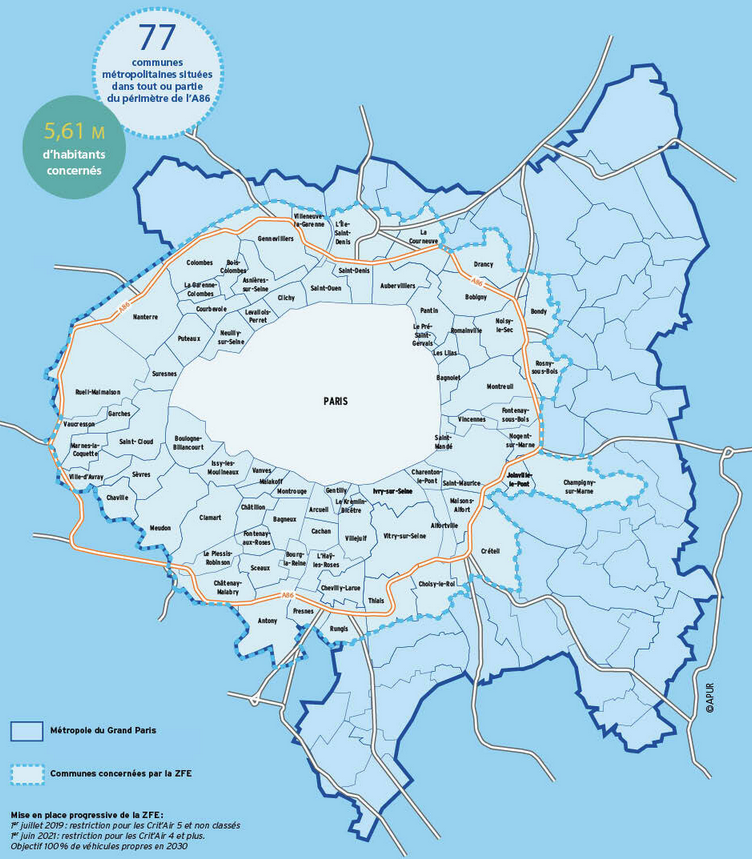
Crit'air Classes
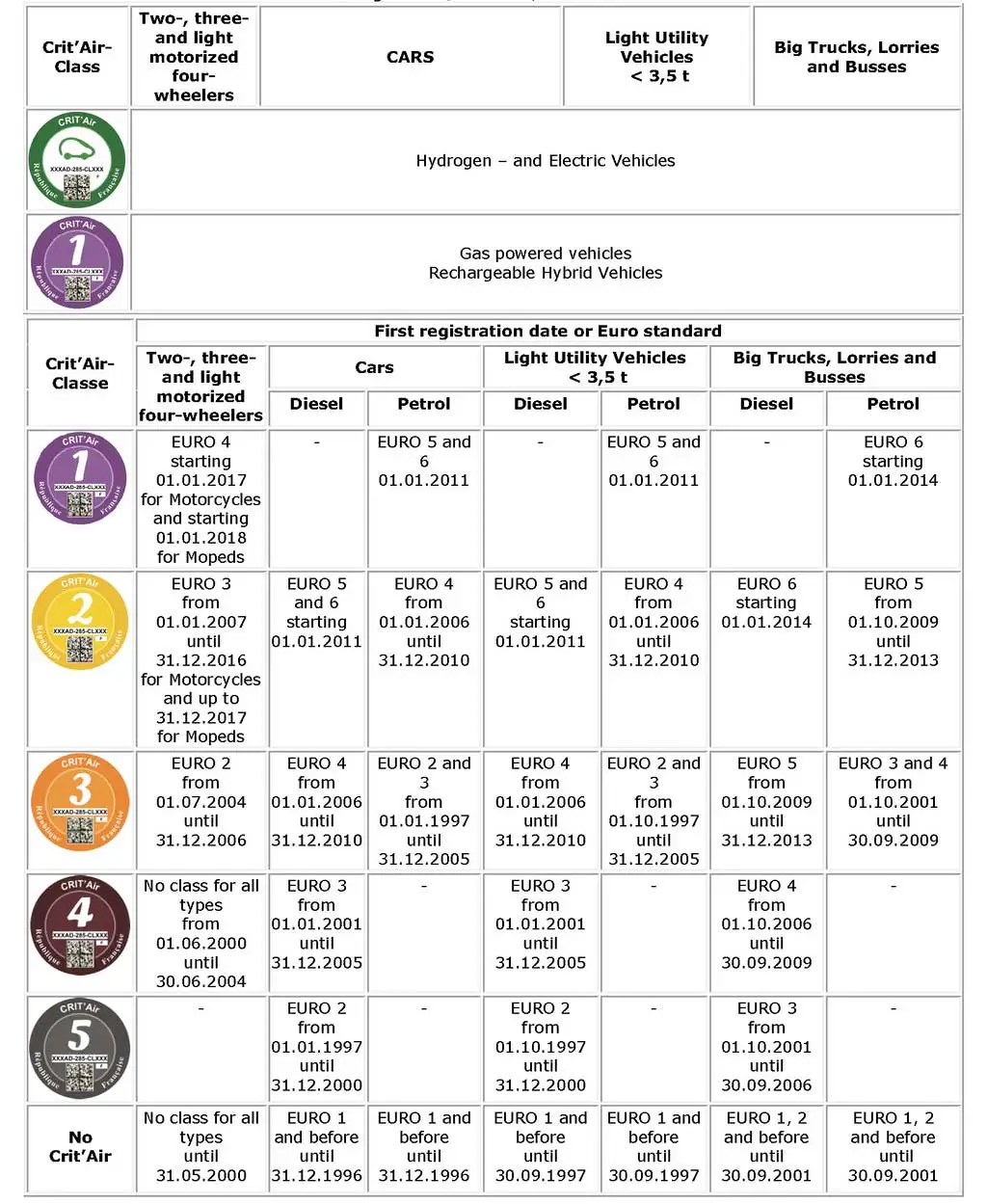
Research Questions
- What is the impact of the Low Emission Zone of the Métropole du Grand Paris on consumer surplus?
- Which people are winning and losing from the Low Emission Zone (based on origin, destination and vehicle owned)?
The research is conducted using Metropolis, an agent-based, mesoscopic and dynamic transport simulator, based on utility maximation. A new version has been developed to handle different vehicle types and road restrictions.
Literature Review
Impact of Low Emission Zones:
Agent-based transport simulators:
- Empirical evaluation: focus on environmental impact, ambiguous effect (Holman et al., 2015; Wolff, 2014; Margaryan, 2021)
-
Ex-ante evaluation:
- Carslaw and Beevers (2002): approached based on traffic flow data, using an emission and dilution model
- Dias et al. (2016): macroscopic transport model
- Bok el al. (2022): agent-based model, focus on freight transport
Agent-based transport simulators:
- MATSim (Axhausen et al., 2016): activity-based, behavior-oriented
- SimMobility (Adnan et al., 2016): activity-based, hierarchical discrete choice modeling
Outline
- Presentation of the transport simulator Metropolis
- Application to Paris' urban area
- Preliminary results: aggregate results, winners and losers from the LEZ
Metropolis
Introduction
- Scope: Île-de-France, trips by car between 3AM and 10AM, all purposes, representative working day
-
Limits:
- No mode choice
- No car-ownership model
- Trucks are not considered
- Time restrictions are not taken into account
- Cheating and exceptions are not considered
Input: Road network
- Source: OpenStreetMap
- Highway types: motorway, trunk, primary, secondary, tertiary, living street, unclassified and residential
- Living streets, unclassified and residential roads are discarded when not used
- Final network has 40 852 km of roads (out of 91 859 km in the full network)

Input: Population
- Generation of a synthetic population using Hörl and Balac (2021)
- Data sources: INSEE census, household travel survey, FiLoSoFi (household income), BD-TOPO (buildings data), SIRENE (entreprise census) and BPE (service and facility census)
- Simulated household-level characteristics: car availability, bike availability, income
-
Simulated individual-level characteristics:
- all activities performed during a day (home, work, education, leisure, shopping, other) with the activity duration and exact location
- age, employment status, sex, socio-professional category, driving license, public-transit subscription
- Final population: 193 235 agents, with 254 585 trips (population and capacities are scaled down to 10 %)
Hörl, S. and Balac, M., 2021. Synthetic population and travel demand for Paris and Île-de-France based on open and publicly available data. Transportation Research Part C: Emerging Technologies, 130, p.103291.
Basic Principle
- Metropolis is an iterative model
- At each iteration, four models are run successively (network skims computation, pre-day model, within-day model and day-to-day model)
- The simulation stops when a convergence criteria is met or when the maximum number of iterations is reached
Network skims computation
- Input: time-dependent travel-time function for each road of the road-network graph
- Step 1: compute a time-dependent Hierarchy Overlay of the graph
- Step 2: compute search spaces for each origin and destination node
- Step 3: compute profile queries for each origin-destination pair
- Output: time-dependent travel-time function for each origin-destination pair (with at least one trip)
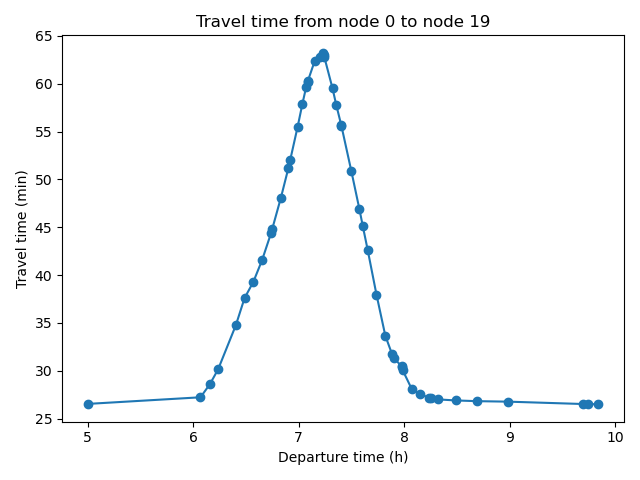
Geisberger, R. and Sanders, P., 2010. Engineering time-dependent
many-to-many shortest paths computation. In
10th Workshop on Algorithmic Approaches for Transportation
Modelling, Optimization, and Systems (ATMOS'10). Schloss Dagstuhl-Leibniz-Zentrum fuer Informatik.
Pre-Day Model
- Input: time-dependent travel-time function for each origin-destination pair
- Output: departure-time and route chosen by each agent
- Departure time is simulated using a Continuous Logit Model and inverse transform sampling
A trip generalized cost is (\( \alpha-\beta-\gamma \) model:
Vickrey, 1969, Arnott, de Palma, Lindsey, 1990) \[ c(t_d, t_a) =
\underbrace{\alpha \cdot (t_a - t_d)}_{\text{travel cost}} +
\underbrace{\beta \cdot [t^* - t_a]_+ + \gamma \cdot [t_a -
t^*]_+}_{\text{schedule-delay cost}} \]
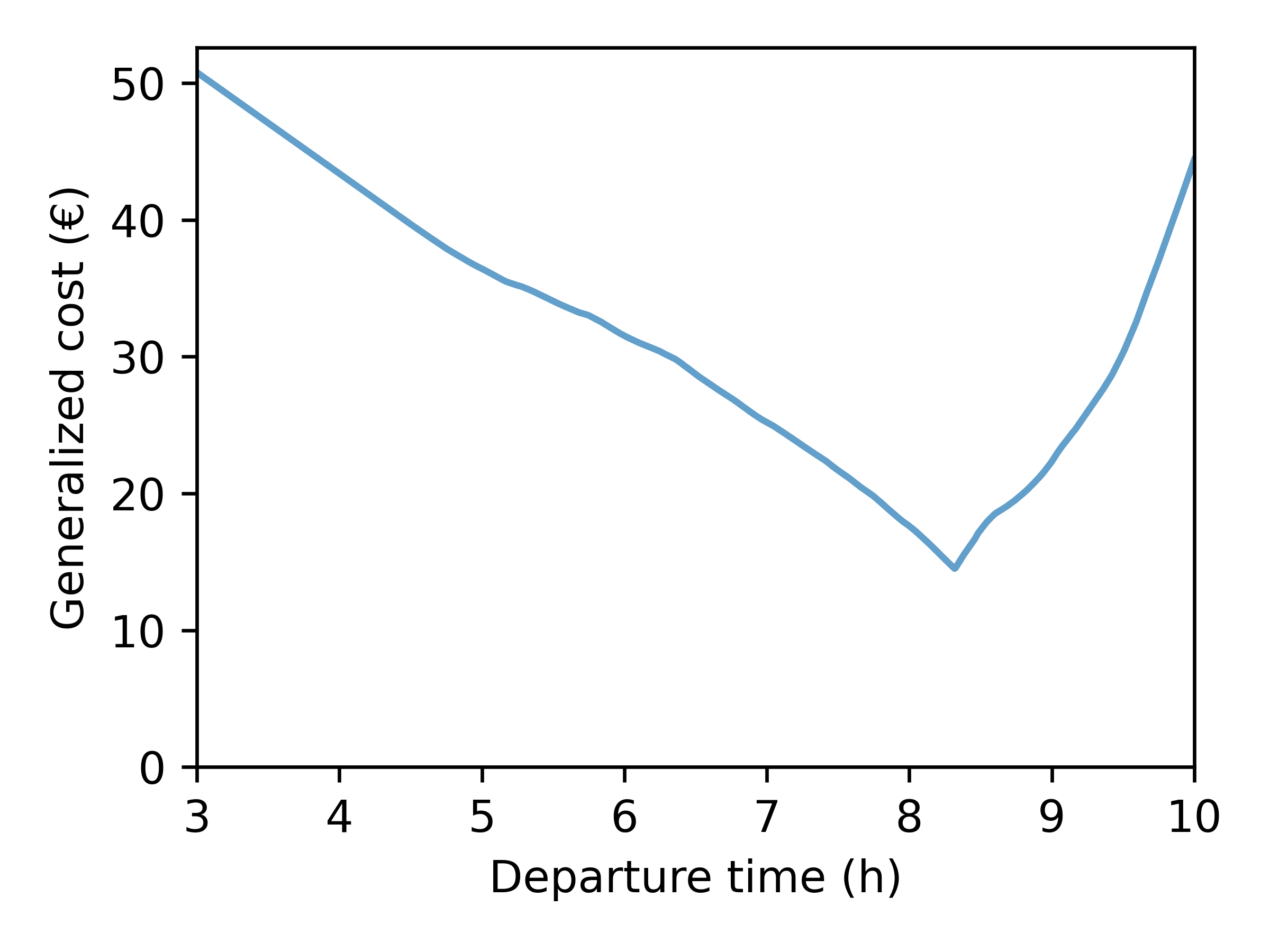
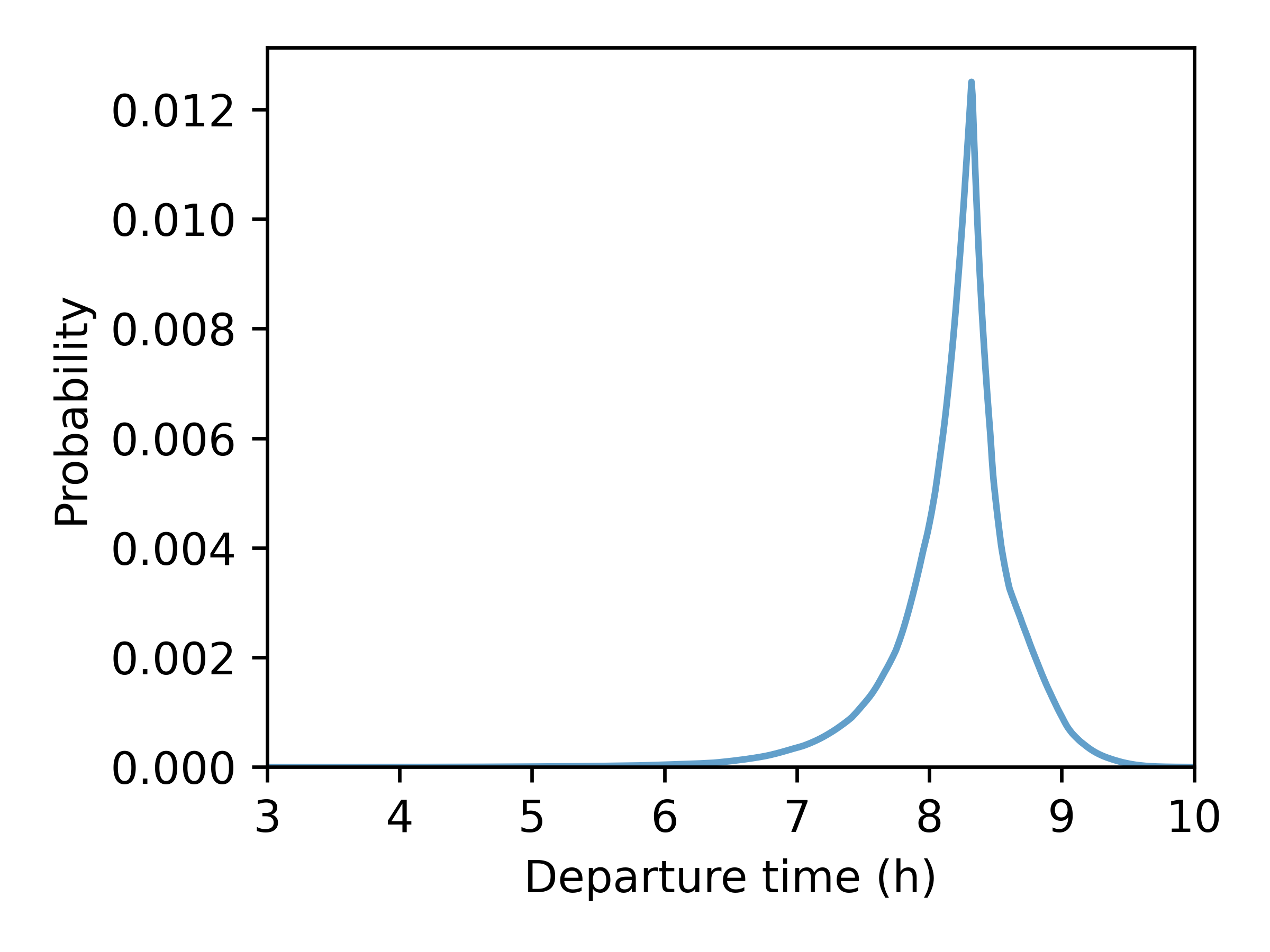
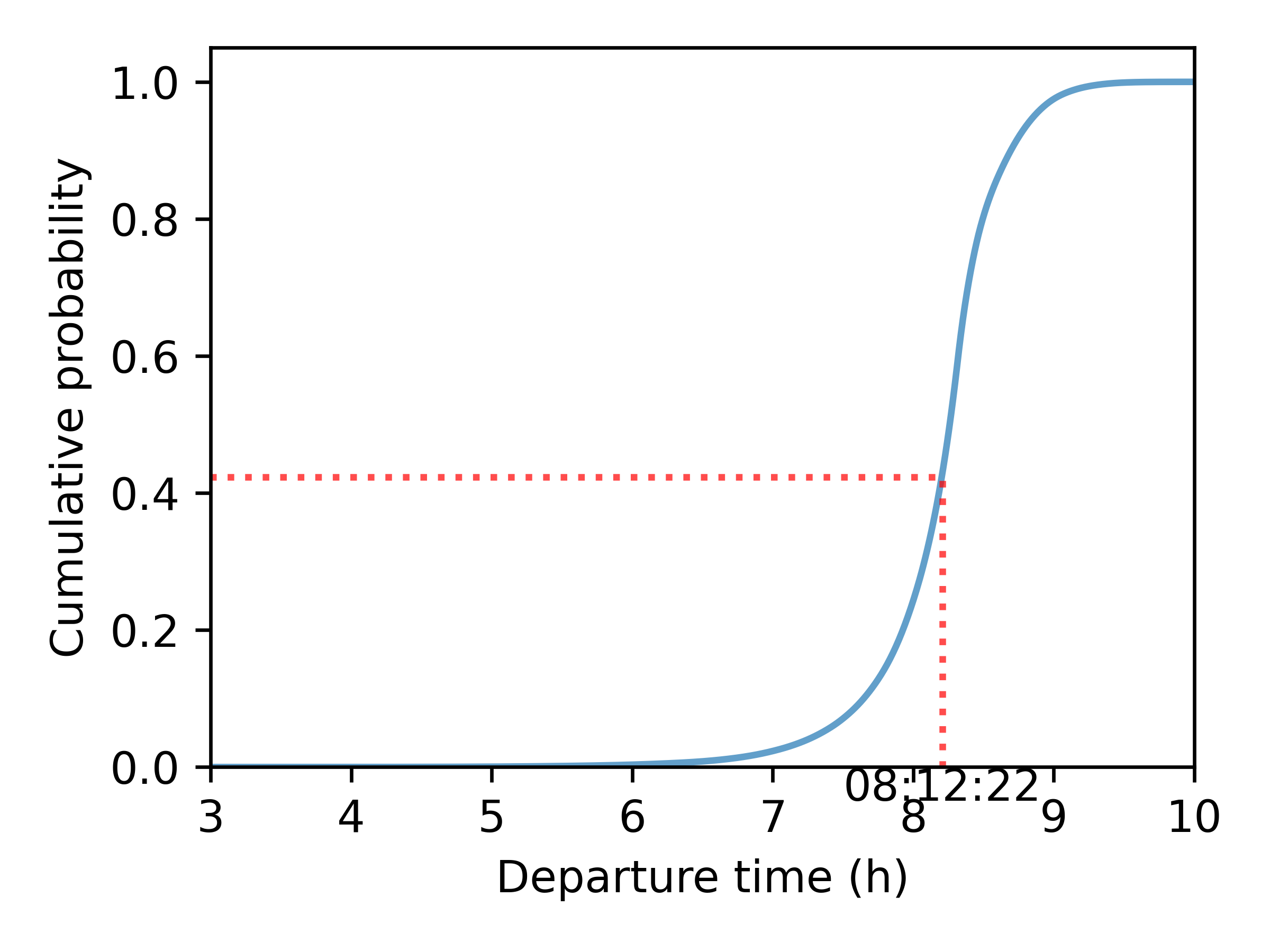
Within-Day Model
- Input: Chosen mode, departure time and route of each agent
- Event-based model: Events represent an agent's or vehicle's action; they are simulated in a chronological order
- Congestion model: combination of speed-density functions, bottlenecks and queue propagation
- Output: Edges' travel-time functions
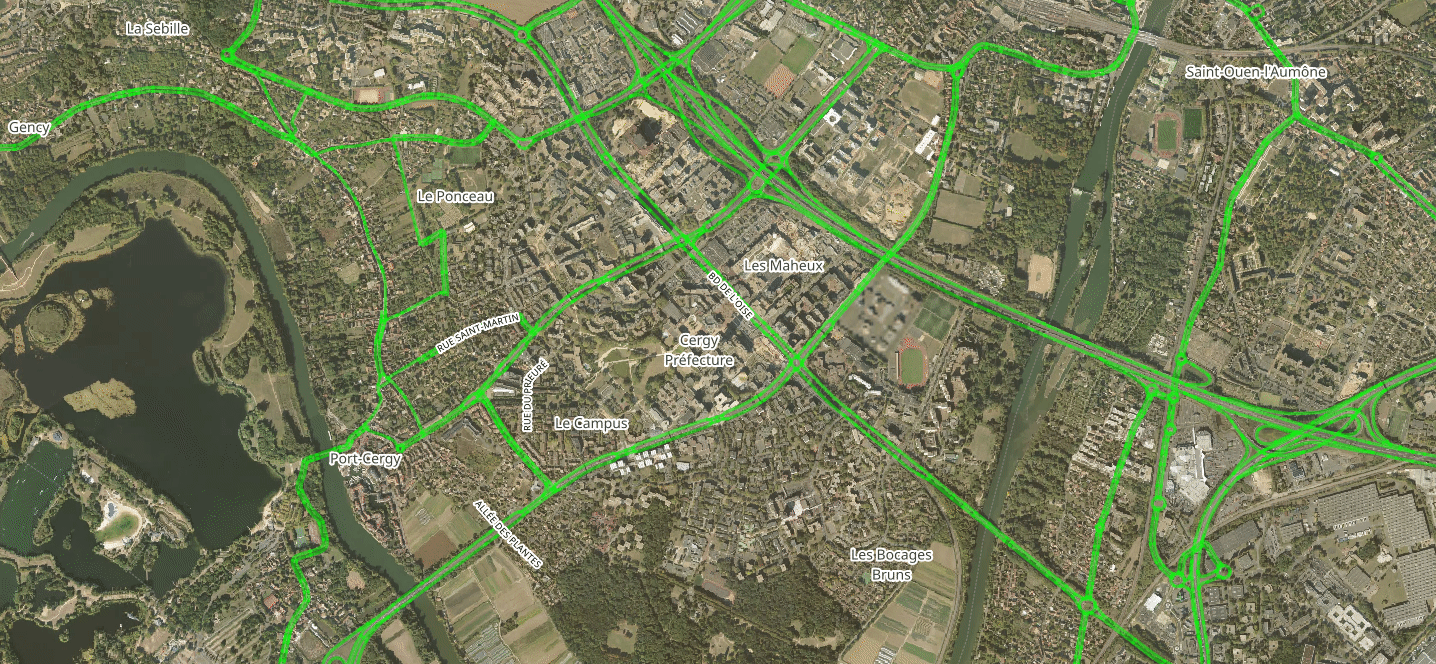

Day-to-Day Model
- Input: Expected and simulated edges' travel-time functions
- Learning process based on Markov decision processes
- Output: Expected edges' travel-time functions for next iteration
\[ {tt}^e_{\tau + 1} = \lambda \cdot {tt}^e_{\tau} + (1 - \lambda)
\cdot {tt}^s_{\tau} \]
Application
Vehicle Types
- Data: Statistics on the vehicle fleet from the French Ministry of Transport (2021)
- INSEE Communes level
- A vehicle is randomly drawn for each agent based on the vehicle fleet from his / her home city
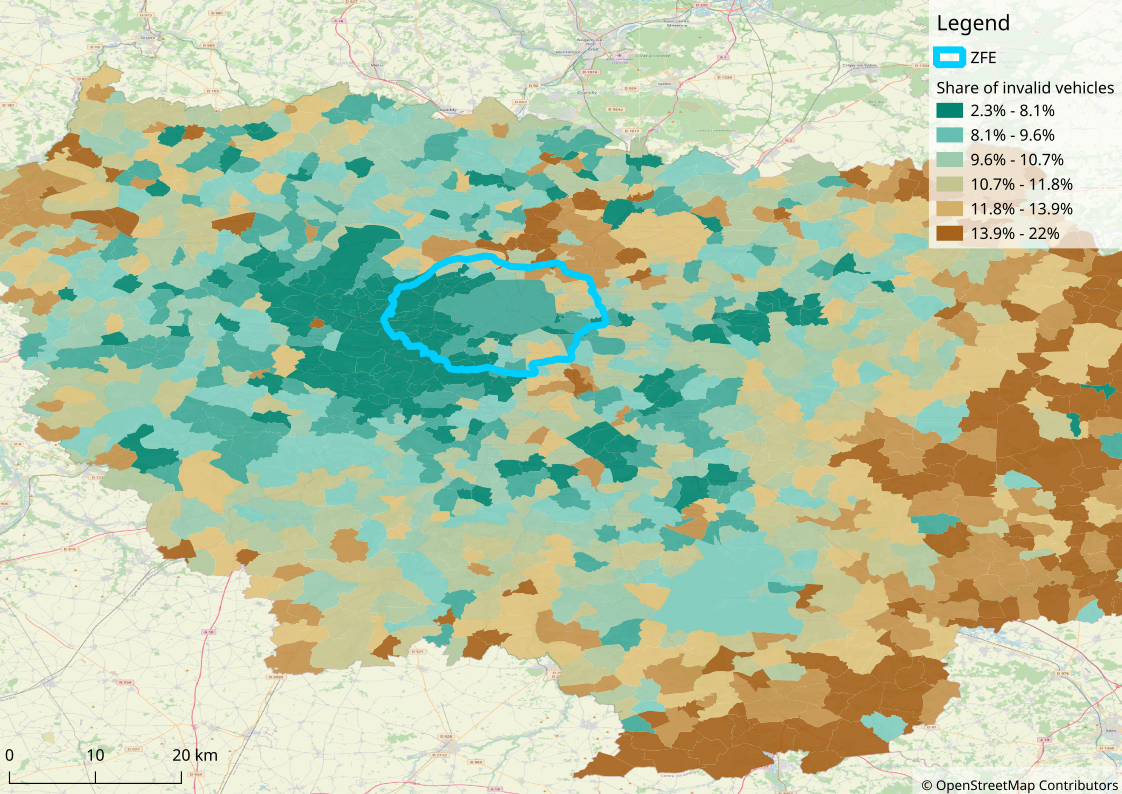
Vehicle Types
The share of polluting vehicle (on the left) is strongly correlated with the median income (on the right)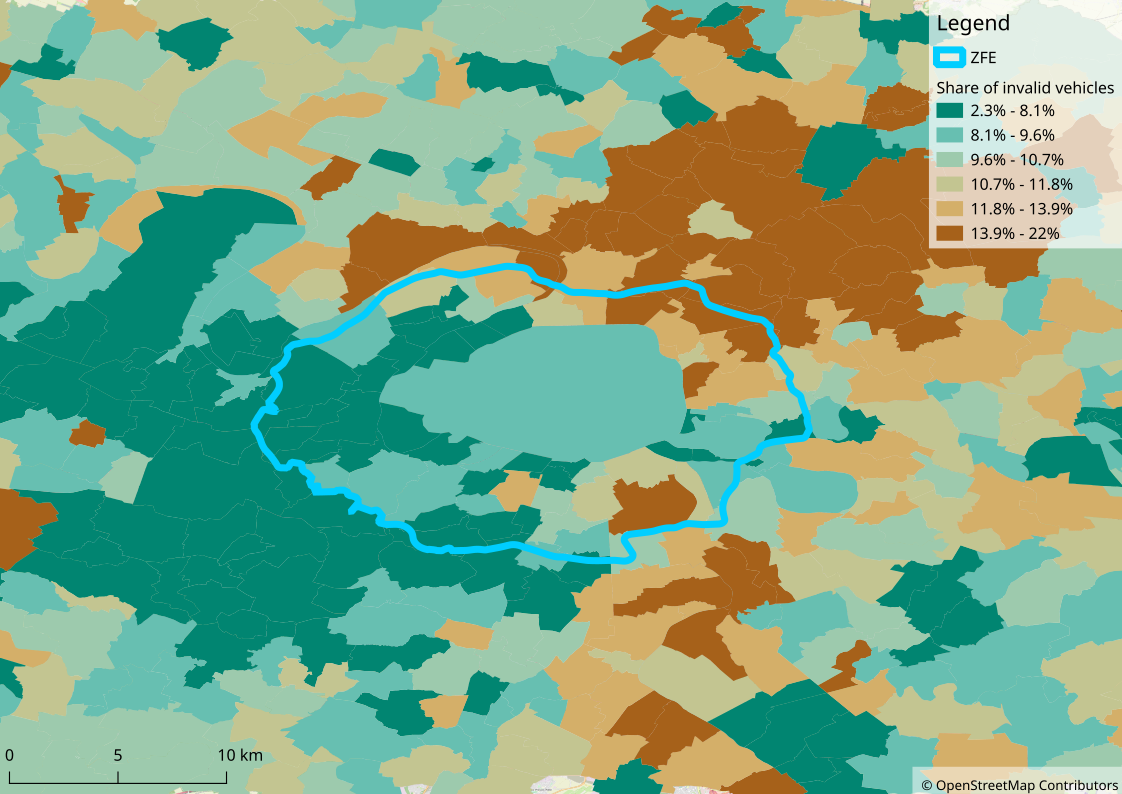

Scenarios
- No-LEZ simulation: Simulation without the Low Emission Zone
- LEZ-2021 simulation: Crit'air 4 and 5 are forbidden (6.2 % of agents)
- LEZ-2023 simulation: Crit'air 3, 4 and 5 are forbidden (19.1 % of agents)
Note: All vehicles are allowed in the LEZ if the trip starts or ends inside the LEZ (47.1 % of the trips in the LEZ-2023 scenario)

Results
Convergence
Choice stability
- Average departure-time shift (in absolute value) is 1.53 seconds (maximum is 154 seconds), at last iteration
- On average, the route used by each agent is the same as the one from the previous iteration for 97.79 % of its length, at last iteration


Convergence
Expected congestion stability
The average travel time anticipated is equal to 16 minutes and 58 seconds (\(\pm\)1s) for the last 50 iterations.
Convergence
Correctness of Anticipations
- EXPECT: relative difference between the anticipated and simulated travel times
- On average, agents under-estimate or over-estimate their travel time by 9.5 % (= 1'45''), at the last iteration

Aggregate Results
| No LEZ | LEZ-2021 | LEZ-2023 | |
|---|---|---|---|
| Departure time | 07:35:16 | 07:35:15 | 07:35:20 |
| Travel time | 17'42'' | 17'45'' | 17'56'' |
| Route length (m) | 13 617 | 13 616 | 13 629 |
| Surplus (euros) | -9.56 | -9.61 | -9.77 |
Global impact (for 1.9 M car drivers, 200-day year, between 3AM and 10AM):
- 17.392 million euros in the LEZ-2021 scenario compared to No-LEZ
- 78.840 million euros in the LEZ-2023 scenario compared to No-LEZ
By comparison, yearly cost of air pollution is estimated to be 3.505 billions euros (Delft, 2020)
Results by Population Groups
Comparison between LEZ-2023 and No-LEZ scenario, by groups| Share | \( \Delta \) travel time | \( \Delta \) route length (m) | \( \Delta \) surplus (euro) | |
|---|---|---|---|---|
| Full in LEZ | 27.0 % | +4'' | +6 | -0.09 |
| Start or end in LEZ | 21.2 % | +27'' | +3 | -0.27 |
| Cross / Allowed | 0.7 % | +1'6'' | -45 | -0.47 |
| Do not cross / Allowed | 32.4 % | +5'' | 0 | -0.03 |
| Cross / Banned | 0.4 % | +4'23'' | +3067 | -1.37 |
| Do not cross / Banned | 18.3 % | +5'' | -3 | -0.04 |

Traffic Counts Change
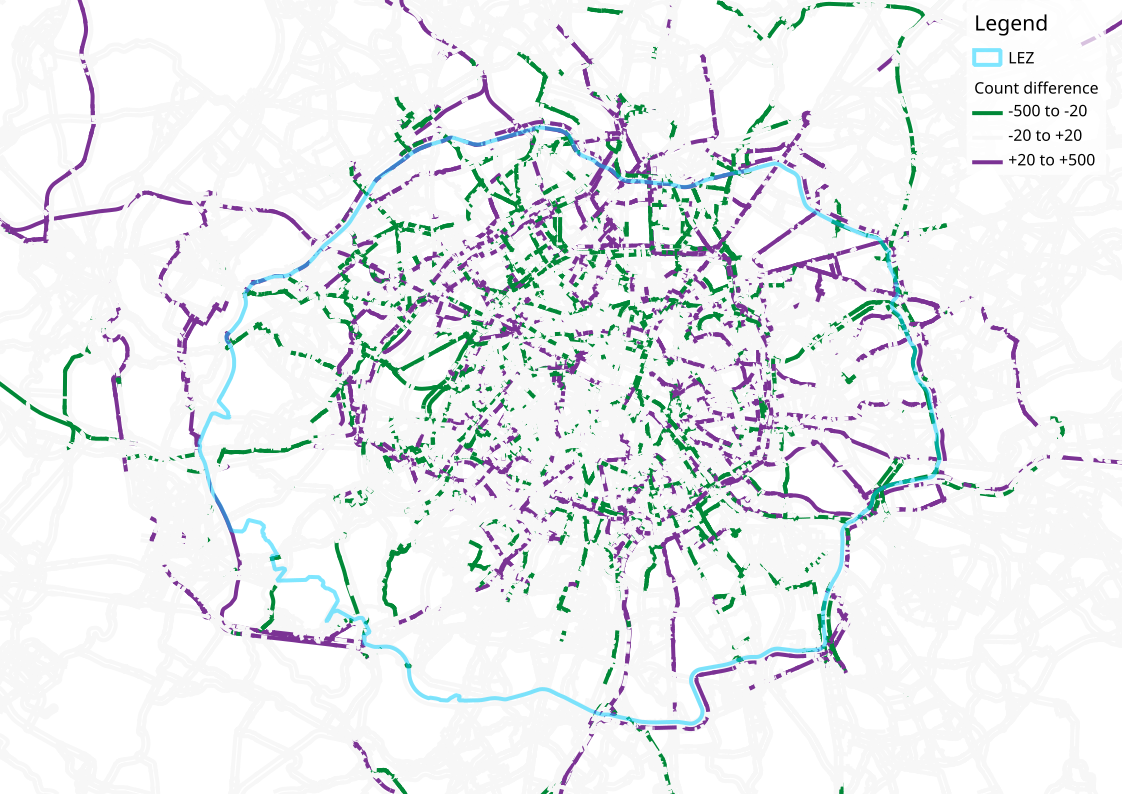
Hypothetical Scenario
We assume that
the owner of polluting car switch to public transit when the
trip is unfeasible
Note 1: The cost of pollution accounts for NOx, CO, PM2.5 and CO2.
Note 2: The surplus loss of the 311 700 agents switching from car to public transit is not computed.
| No LEZ | LEZ-2023 | Variation | |
|---|---|---|---|
| Nb. car drivers | 1 932 350 | 1 620 650 | -16 % |
| Av. travel time | 16'20'' | 13'28'' | -18 % |
| Av. route length | 13.01 km | 12.92 km | -1 % |
| User surplus | -14.408 M€ | -12.592 M€ | +1.82 M€ (+13 %) |
| Cost of pollution | 11.051 M€ | 8.794 M€ | -2.26 M€ (-20 %) |
Note 1: The cost of pollution accounts for NOx, CO, PM2.5 and CO2.
Note 2: The surplus loss of the 311 700 agents switching from car to public transit is not computed.
Conclusion
Conclusion
Results
Future works
- Metropolis is adapted to study the heterogeneous effect of a policy (such as a LEZ)
-
When considering only traffic congestion, Paris' LEZ has
- no significant effect on the people that do not need to cross the LEZ (77.7 %)
- an ambiguous effect on the people owning a clean car that need to cross the LEZ (21.9 %)
- a negative effect on the people owning a polluting car that need to cross the LEZ (0.4 %)
Future works
- Mode choice
- Car ownership
- Calibration and validation
- Improve convergence
- Additional results (results by demographic groups, air pollution)